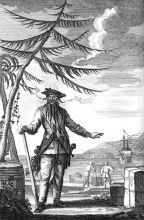
Ocracoke Island is the most remote inhabited island of the Banks, and Ocracoke is the southernmost town within the limits of the National Park.
From the Outer Banks, it's reached by ferry from Hatteras Village. The trip across is relatively fast – a little more than an hour most days, free and scenic, following a winding course west of Hatteras Inlet, in the calm waters of the sound. Even when the surf breaks whitely on the bar the ferry hardly rolls. You’ll see visitors feeding the gulls that hover over the moving ferry and dive for tidbits, but you’ll also notice that folks you might identify as more seasoned ferry riders discourage this activity due to the unfortunate wet substances that emanate from these feathered creatures.
Bring binoculars, if you own a pair. To your left as the ferry hums along you can see the distinctive vegetation and wildlife of the sound side of the banks. Low, sandy islets slip by on either side as the ferry approaches the pier on the northeastern end of Ocracoke Island, and Highway 12 resumes
Most of the island is still just as uninhabited as you drive down it as it was on a spring day in 1585 when seven English ships appeared off Ocracoke Inlet.
Sir Richard Grenville was in command, a seasoned, experienced soldier. He had about 300 troops aboard his fleet. His mission, entrusted to him by Sir Walter Raleigh and the Queen, was to establish a permanent English base in the New World. He was to fail at Roanoke Island; but that summer no one yet suspected the fate that awaited those first colonists.
The Banks welcomed him in characteristic fashion, leaving his flagship, Tiger, hard aground on the bar. He and Ralph Lane took advantage of the delay to explore north and west in smaller vessels. When the ship was floated and repaired, he headed to Roanoke, leaving the island sleeping and deserted once again.
It's thought that the name Woccocon, which was applied to the island at first, was derived from the neighboring Indian tribe the Woccons. But its precise derivation, like that of so many Outer Banks names, is unclear, as is its subsequent degeneration through Wococock, Occocock, Ocreecock, and other variations to the present Ocracoke. Spelling held a low priority in those days, a state to which the English tongue seems to be reverting.
Most of the island remained in its wild state with sheep, cattle and horses released by the early owners to graze freely. But the gradual increase in colonial trade in the early 18th century saw more and more ships using the Inlet, in those days deeper than it is now (too, ships, were of shallower draft). In 1715 the colony of North Carolina established Ocracoke as a port, setting aside land on the western tip of the island for the homes of pilots (for Midwesterners, and other non-seagoing types, a pilot meets incoming ships at sea and guides them safely in. Pilots are generally older men, brine encrusted, who know the configurations of sand bars and channels from painful experience).
A new problem also arose: pirates. They interfered with the pilots, terrorized the inhabitants of the islands, boarded and robbed ships at sea, murdered crews and passengers and made themselves generally unwelcome. John Cole, Robert Deal, Anne Bonny and dozens of others operated along the Caribbean and Southern Atlantic coasts in the early 18th century.
But it was the notorious Blackbeard, standing out as the worst of a bad lot, who left his name stamped on the Outer Banks and on Ocracoke, one of his lairs. Much of his early career lies somewhere between conjecture and legend. It is thought that he started as an honest English tar named Edward Drummond, born, perhaps, in Bristol.
He may have started, like many pirates, as a privateer – a sort of seagoing guerrilla. But by 1716 he had turned pirate, calling himself Edward Teach. He had found his métier, and his rise was rapid. He seems to have been a man of organizational ability, for in short order he was in command of a sizeable fleet of ships and some hundreds of men.
He also understood advertising. An evil reputation is a great thing to a terrorist, for it weakens the other side's morale and leads to quick capitulations. Blackbeard was a master in dressing for success and winning through intimidation. Tall, broad and with a bushy coal-black beard, he festooned himself with cutlasses, dirks and loaded pistols. In battle his beard was plaited, with little ribbons to add a festive air. Lighted cannon fuses dangled from under his hat, an affectation of dubious safety with primed flintlocks in his belt but unquestionably effective in giving him the air of the very of devil.
And a devil with political clout. He bought Governor Eden, of North Carolina, and was able to move ashore to Bath with his booty in 1718. Like many men, he became bored with retirement, and before the year was up he was out raiding again part-time. Eden stayed bought and did nothing, so a few citizens went north to ask a favor of Governor Spotswood of Virginia.
Spotswood sent the Royal Navy. In November of 1718, Lt. Robert Maynard left the James River, heading south in two sloops manned with sailors from British men-o' –war. Maynard must have had confidence in himself; his two small sloops had no cannon, only small arms. The shallow-draft boats were able to penetrate where larger warships could not go, and Maynard was able to track Blackbeard's Adventure to Ocracoke Inlet.
Dawn, November 22. Ocracoke Inlet resounded to the boom of pirate guns and the crackle of British musketry fire. The Adventure grounded, but her well-laid cannon took heavy toll of the Royal Navy men. Maynard ordered them below then stood ready on deck as his sloop drifted down on the larger ship.
They met. Teach's men launched a volley of grenades and swarmed aboard. The sailors came up from below to begin a merciless hand-to-hand struggle. The pirate chief and the lieutenant faced each other. An exchange of pistol balls wounded the pirate, but in the next moment he had broken the officer's sword with his cutlass. Another sailor sliced the massive buccaneer in the neck, but he fought on . . . then collapsed. The battle was over. The pirate's head was cut off and hung from the rigging for the trip back that all might see he was dead. The body was thrown overboard, where, island legend has it, it swam seven times round the ship before sinking. Most of the rest of his crew were taken to Williamsburg and given a fair trial before they were hanged. His treasure? Probably there was none – he spent what little money the coasting trade yielded. But legends persist. . . .
With the pirates cleaned out, trade flourished. Most of the seaborne commerce of North Carolina, and much of that of Virginia, came through the inlet, and gradually families settled there to service the ships. There were sporadic Spanish incursions and raids in the 1740s and ‘50s, and at one time they even had a camp on the island. Eventually peace came between England and Spain and they went home.
It was in 1753 that the village became a recognized town, and then there were only about a hundred inhabitants. Most of the island remained in a wild state. The inlet was fortified in 1757. Across the water, the town of Portsmouth was also growing up, and the little port of Beacon Island Roads, as the two towns were commonly called, was doing well when the Revolution arrived. Much of Washington's army was supplied through Ocracoke, and coastal North Carolina trade remained intact although the British patrolled outside, landed troops and engaged in various futile retaliations.
After the war, the lighthouses were built by the new government, the first in 1798 on Shell Castle Rock, the second (the present one) in 1823. But even as they went up, the golden age of Ocracoke was drawing to an end. Hatteras and Oregon inlets opened during a storm in September of 1846, and as these were deepened by outflow, Ocracoke Inlet began to shoal. The fort was abandoned by the Confederates in 1861, and the Government sank several ships loaded with rock in the channel to seal it. Such seagoing traffic as remained to the Banks – for by now oceangoing ships had grown much larger and deeper – shifted to Hatteras Inlet. After the war the village declined to a hundred or so inhabitants who subsisted as fishermen, boatmen or lifesavers. Many went to sea, and not all of them returned.
It took a war to bring new life. Silver Lake Harbor (formerly Cockle Creek) had been dredged out in 1931, and in 1942 a naval base was established there. As cargo ships burned offshore, as oil and debris and dead bodies drifted ashore, telephones and paved roads were brought to the villagers. The base was closed in 1945, but in the mid-‘50s the National Seashore and the highway brought a new source of revenue: the tourist.
Today tourism has taken over from fishing as the island's livelihood. And they do come, more every year, in an economy that brings loads of tourists in the summer and well into the fall. More visitors are catching on, too, that off-season on Ocracoke is a thing of real joy.
Electricity came in 1938 and the first paved road in 1951. In the late 1970s an ABC store, a doctor and a night spot arrived; in 1985, television, in the form of a 3.5-meter dish and cable; in 1987 the first multistory hotel and the first lakefront condo opened. Present day? Rentable golf carts have helped take some of the car traffic off the narrow island roads; you’ll find an abundance of very good restaurants; tons of gift shops are found in repurposed older homes; hotels offer all the amenities you’d expect, including WiFi and flat screen TVs; you can get your big city amazingly delicious coffee creations; the bartenders here are expert at their craft.
But a walk or a bike ride will show you that Ocracoke hasn't been spoiled. There's still no real crime to speak of, not one fast-food joint and not a single national chain store. And on soft summer nights, a walk or bike around the island will still bring you quiet, peace and fireflies. It’s as close to inner peace as many Americans will ever get.
And still, to the north and east . . . Ocracoke Island stretches out unpopulated and untamed. The sea roars against the rows of dunes; the road, silent and empty, shimmers amid the beach grass and yaupon. Toward the sound the ponies graze warily, and Ocracoke is quiet by the jealous sea.






